GlaxoSmithKline (GSK): A Corporate Strategy Analysis and Evaluation
VerifiedAdded on 2020/10/22
|13
|4126
|226
Report
AI Summary
This report provides a comprehensive analysis of GlaxoSmithKline (GSK)'s corporate strategy. It begins with an external analysis, identifying opportunities and threats using PESTLE and Porter's Five Forces models to assess industry attractiveness. The report then delves into an analysis of GSK's resources and key competencies, utilizing a SWOT analysis to determine core competencies. Finally, it evaluates a recently implemented strategy using SAFe criteria. The report covers political, economic, social, technological, environmental, and legal factors impacting GSK. The analysis includes the bargaining power of buyers and suppliers, threats of new entrants and substitutes, and the level of rivalry among competitors. The internal analysis examines GSK's strengths and weaknesses, identifying opportunities for strategic expansion through acquisitions and collaborations and the increasing demand for quality healthcare. The report highlights the importance of R&D and a strong sales and distribution network. The conclusion summarizes the key findings and provides insights into GSK's strategic positioning in the pharmaceutical industry.
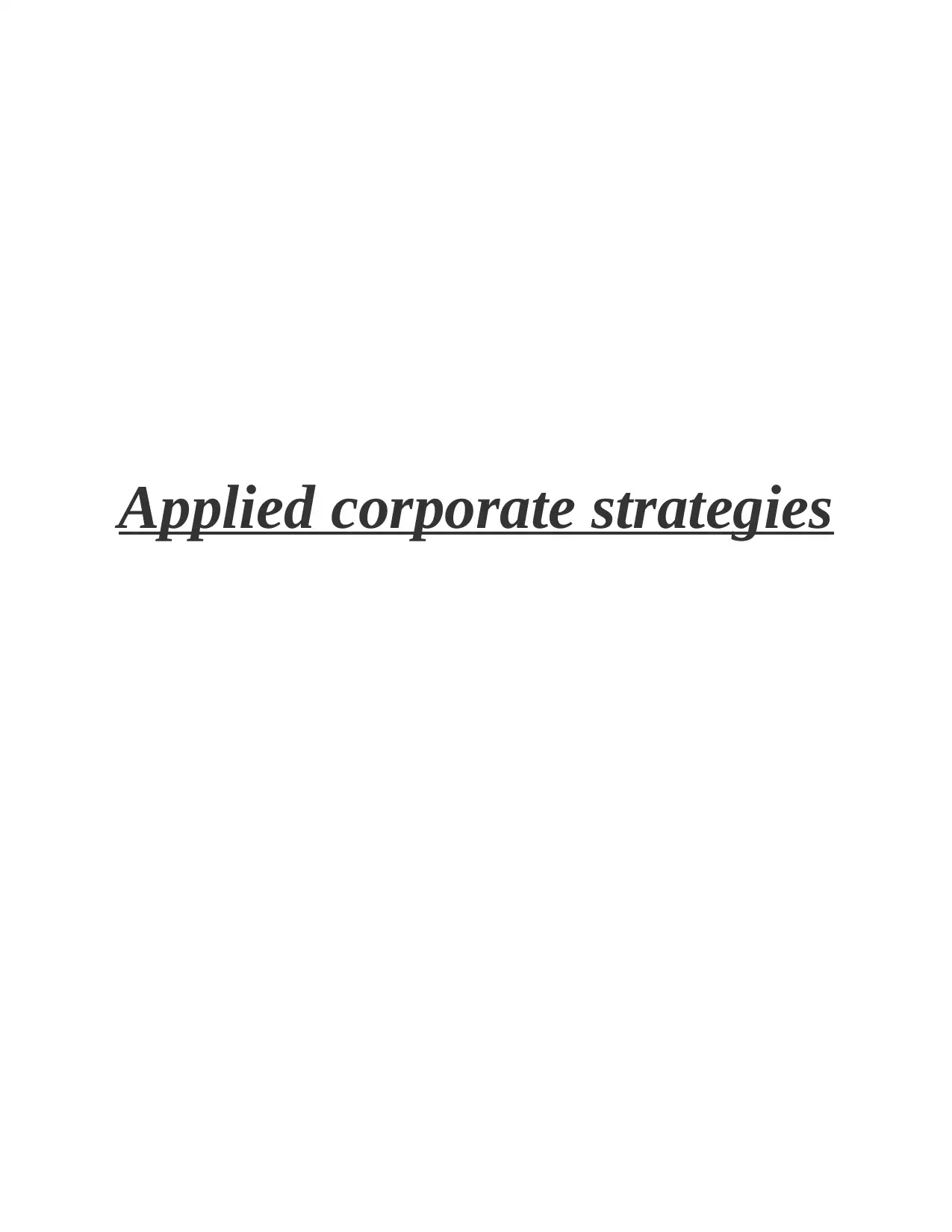
Applied corporate strategies
Paraphrase This Document
Need a fresh take? Get an instant paraphrase of this document with our AI Paraphraser
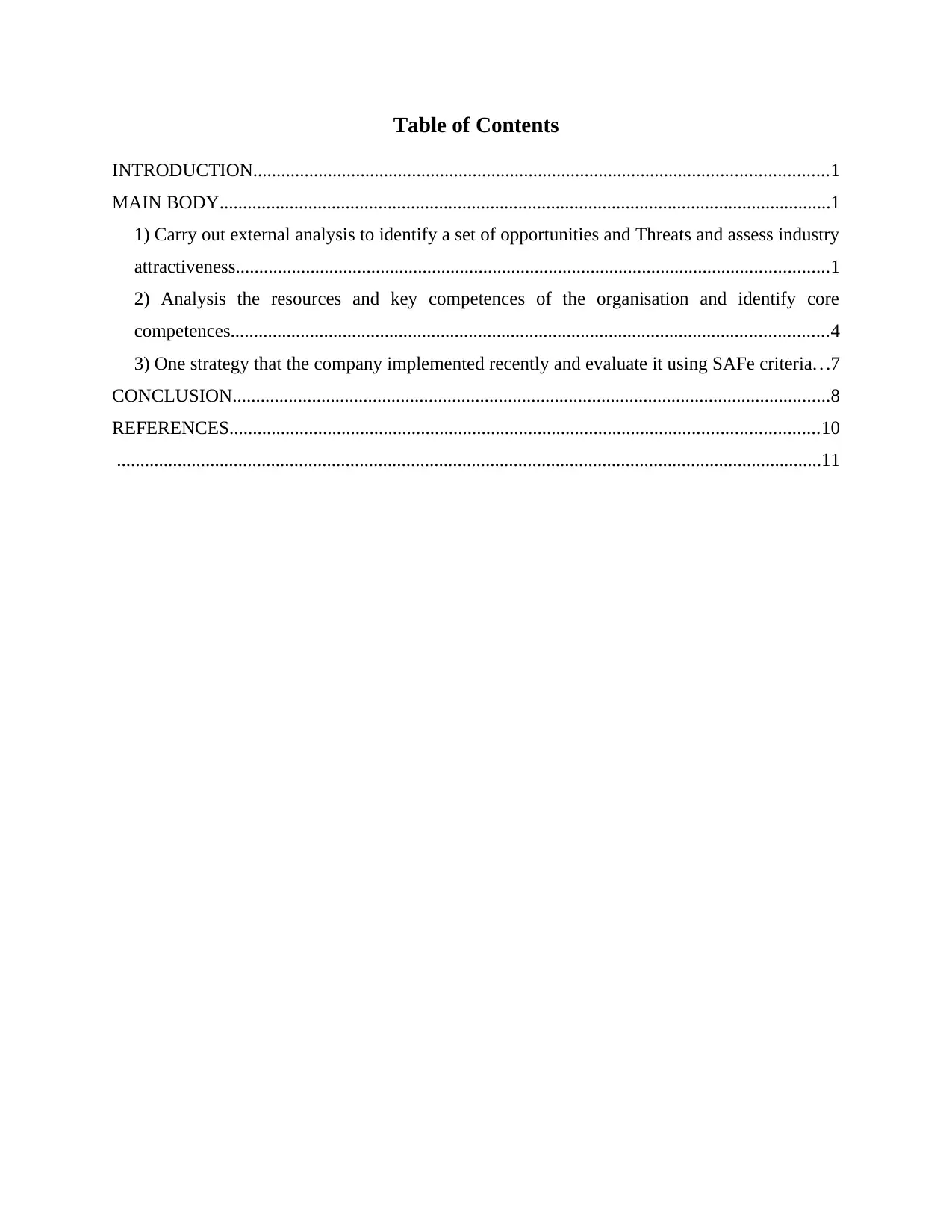
Table of Contents
INTRODUCTION...........................................................................................................................1
MAIN BODY...................................................................................................................................1
1) Carry out external analysis to identify a set of opportunities and Threats and assess industry
attractiveness...............................................................................................................................1
2) Analysis the resources and key competences of the organisation and identify core
competences................................................................................................................................4
3) One strategy that the company implemented recently and evaluate it using SAFe criteria. . .7
CONCLUSION................................................................................................................................8
REFERENCES..............................................................................................................................10
.......................................................................................................................................................11
INTRODUCTION...........................................................................................................................1
MAIN BODY...................................................................................................................................1
1) Carry out external analysis to identify a set of opportunities and Threats and assess industry
attractiveness...............................................................................................................................1
2) Analysis the resources and key competences of the organisation and identify core
competences................................................................................................................................4
3) One strategy that the company implemented recently and evaluate it using SAFe criteria. . .7
CONCLUSION................................................................................................................................8
REFERENCES..............................................................................................................................10
.......................................................................................................................................................11
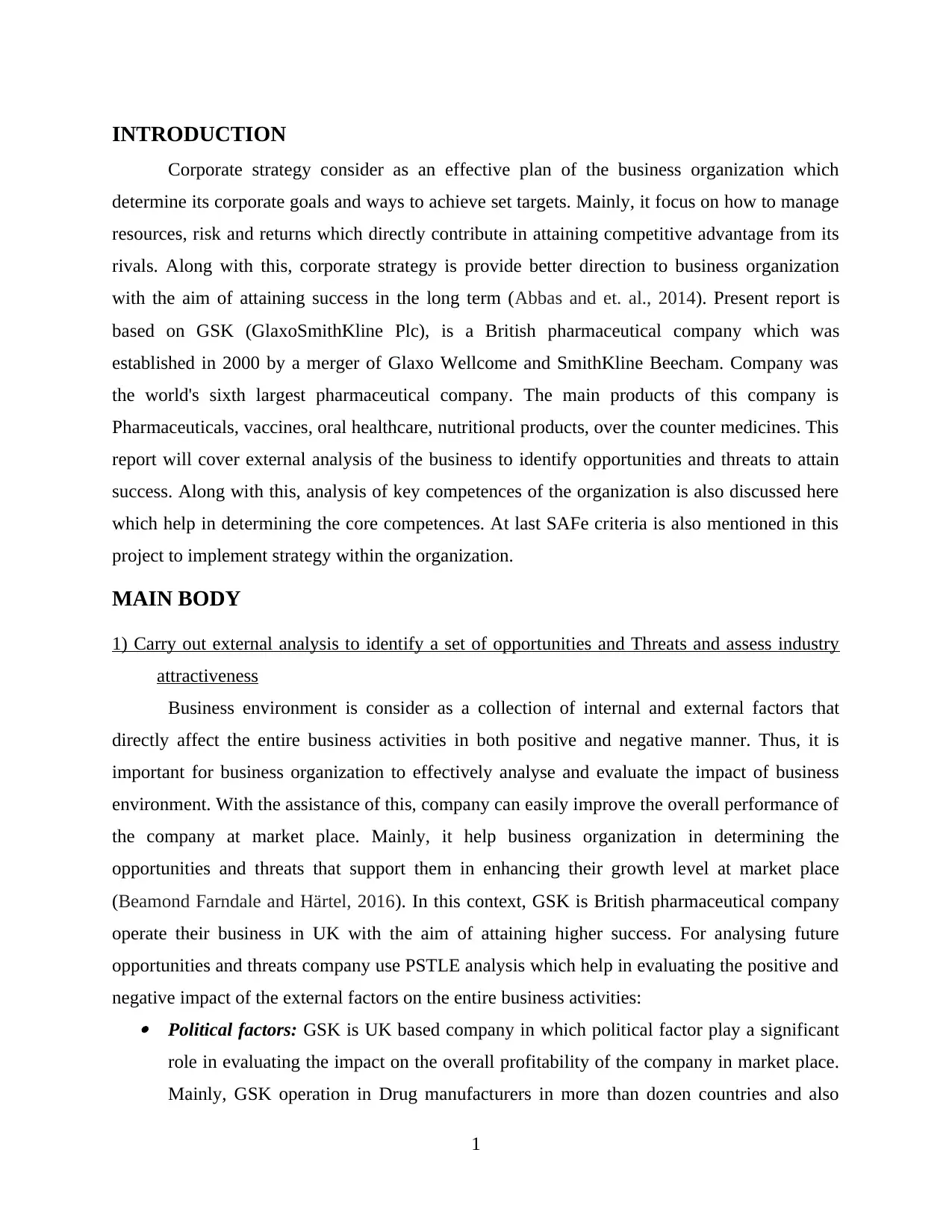
INTRODUCTION
Corporate strategy consider as an effective plan of the business organization which
determine its corporate goals and ways to achieve set targets. Mainly, it focus on how to manage
resources, risk and returns which directly contribute in attaining competitive advantage from its
rivals. Along with this, corporate strategy is provide better direction to business organization
with the aim of attaining success in the long term (Abbas and et. al., 2014). Present report is
based on GSK (GlaxoSmithKline Plc), is a British pharmaceutical company which was
established in 2000 by a merger of Glaxo Wellcome and SmithKline Beecham. Company was
the world's sixth largest pharmaceutical company. The main products of this company is
Pharmaceuticals, vaccines, oral healthcare, nutritional products, over the counter medicines. This
report will cover external analysis of the business to identify opportunities and threats to attain
success. Along with this, analysis of key competences of the organization is also discussed here
which help in determining the core competences. At last SAFe criteria is also mentioned in this
project to implement strategy within the organization.
MAIN BODY
1) Carry out external analysis to identify a set of opportunities and Threats and assess industry
attractiveness
Business environment is consider as a collection of internal and external factors that
directly affect the entire business activities in both positive and negative manner. Thus, it is
important for business organization to effectively analyse and evaluate the impact of business
environment. With the assistance of this, company can easily improve the overall performance of
the company at market place. Mainly, it help business organization in determining the
opportunities and threats that support them in enhancing their growth level at market place
(Beamond Farndale and Härtel, 2016). In this context, GSK is British pharmaceutical company
operate their business in UK with the aim of attaining higher success. For analysing future
opportunities and threats company use PSTLE analysis which help in evaluating the positive and
negative impact of the external factors on the entire business activities: Political factors: GSK is UK based company in which political factor play a significant
role in evaluating the impact on the overall profitability of the company in market place.
Mainly, GSK operation in Drug manufacturers in more than dozen countries and also
1
Corporate strategy consider as an effective plan of the business organization which
determine its corporate goals and ways to achieve set targets. Mainly, it focus on how to manage
resources, risk and returns which directly contribute in attaining competitive advantage from its
rivals. Along with this, corporate strategy is provide better direction to business organization
with the aim of attaining success in the long term (Abbas and et. al., 2014). Present report is
based on GSK (GlaxoSmithKline Plc), is a British pharmaceutical company which was
established in 2000 by a merger of Glaxo Wellcome and SmithKline Beecham. Company was
the world's sixth largest pharmaceutical company. The main products of this company is
Pharmaceuticals, vaccines, oral healthcare, nutritional products, over the counter medicines. This
report will cover external analysis of the business to identify opportunities and threats to attain
success. Along with this, analysis of key competences of the organization is also discussed here
which help in determining the core competences. At last SAFe criteria is also mentioned in this
project to implement strategy within the organization.
MAIN BODY
1) Carry out external analysis to identify a set of opportunities and Threats and assess industry
attractiveness
Business environment is consider as a collection of internal and external factors that
directly affect the entire business activities in both positive and negative manner. Thus, it is
important for business organization to effectively analyse and evaluate the impact of business
environment. With the assistance of this, company can easily improve the overall performance of
the company at market place. Mainly, it help business organization in determining the
opportunities and threats that support them in enhancing their growth level at market place
(Beamond Farndale and Härtel, 2016). In this context, GSK is British pharmaceutical company
operate their business in UK with the aim of attaining higher success. For analysing future
opportunities and threats company use PSTLE analysis which help in evaluating the positive and
negative impact of the external factors on the entire business activities: Political factors: GSK is UK based company in which political factor play a significant
role in evaluating the impact on the overall profitability of the company in market place.
Mainly, GSK operation in Drug manufacturers in more than dozen countries and also
1
⊘ This is a preview!⊘
Do you want full access?
Subscribe today to unlock all pages.

Trusted by 1+ million students worldwide
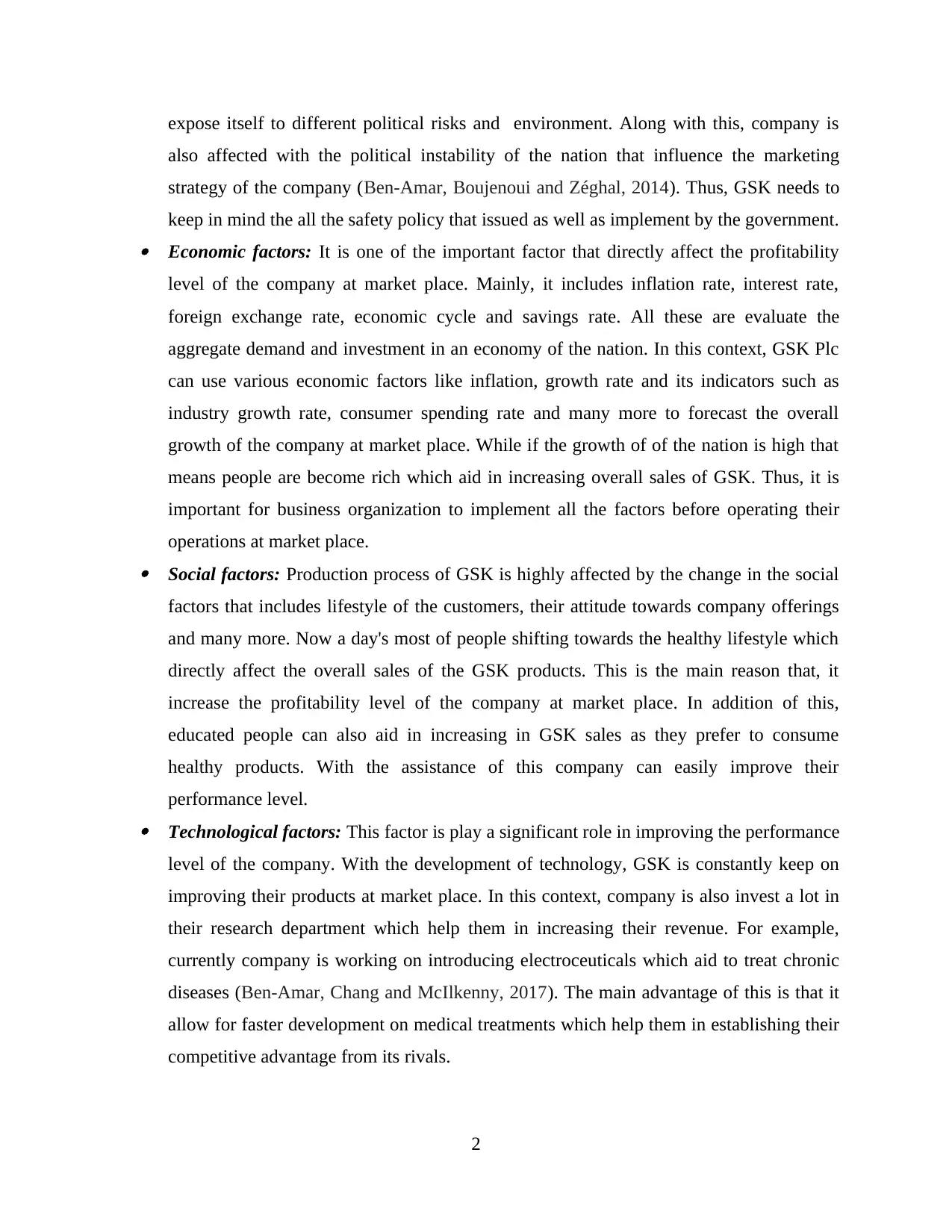
expose itself to different political risks and environment. Along with this, company is
also affected with the political instability of the nation that influence the marketing
strategy of the company (Ben-Amar, Boujenoui and Zéghal, 2014). Thus, GSK needs to
keep in mind the all the safety policy that issued as well as implement by the government. Economic factors: It is one of the important factor that directly affect the profitability
level of the company at market place. Mainly, it includes inflation rate, interest rate,
foreign exchange rate, economic cycle and savings rate. All these are evaluate the
aggregate demand and investment in an economy of the nation. In this context, GSK Plc
can use various economic factors like inflation, growth rate and its indicators such as
industry growth rate, consumer spending rate and many more to forecast the overall
growth of the company at market place. While if the growth of of the nation is high that
means people are become rich which aid in increasing overall sales of GSK. Thus, it is
important for business organization to implement all the factors before operating their
operations at market place. Social factors: Production process of GSK is highly affected by the change in the social
factors that includes lifestyle of the customers, their attitude towards company offerings
and many more. Now a day's most of people shifting towards the healthy lifestyle which
directly affect the overall sales of the GSK products. This is the main reason that, it
increase the profitability level of the company at market place. In addition of this,
educated people can also aid in increasing in GSK sales as they prefer to consume
healthy products. With the assistance of this company can easily improve their
performance level. Technological factors: This factor is play a significant role in improving the performance
level of the company. With the development of technology, GSK is constantly keep on
improving their products at market place. In this context, company is also invest a lot in
their research department which help them in increasing their revenue. For example,
currently company is working on introducing electroceuticals which aid to treat chronic
diseases (Ben-Amar, Chang and McIlkenny, 2017). The main advantage of this is that it
allow for faster development on medical treatments which help them in establishing their
competitive advantage from its rivals.
2
also affected with the political instability of the nation that influence the marketing
strategy of the company (Ben-Amar, Boujenoui and Zéghal, 2014). Thus, GSK needs to
keep in mind the all the safety policy that issued as well as implement by the government. Economic factors: It is one of the important factor that directly affect the profitability
level of the company at market place. Mainly, it includes inflation rate, interest rate,
foreign exchange rate, economic cycle and savings rate. All these are evaluate the
aggregate demand and investment in an economy of the nation. In this context, GSK Plc
can use various economic factors like inflation, growth rate and its indicators such as
industry growth rate, consumer spending rate and many more to forecast the overall
growth of the company at market place. While if the growth of of the nation is high that
means people are become rich which aid in increasing overall sales of GSK. Thus, it is
important for business organization to implement all the factors before operating their
operations at market place. Social factors: Production process of GSK is highly affected by the change in the social
factors that includes lifestyle of the customers, their attitude towards company offerings
and many more. Now a day's most of people shifting towards the healthy lifestyle which
directly affect the overall sales of the GSK products. This is the main reason that, it
increase the profitability level of the company at market place. In addition of this,
educated people can also aid in increasing in GSK sales as they prefer to consume
healthy products. With the assistance of this company can easily improve their
performance level. Technological factors: This factor is play a significant role in improving the performance
level of the company. With the development of technology, GSK is constantly keep on
improving their products at market place. In this context, company is also invest a lot in
their research department which help them in increasing their revenue. For example,
currently company is working on introducing electroceuticals which aid to treat chronic
diseases (Ben-Amar, Chang and McIlkenny, 2017). The main advantage of this is that it
allow for faster development on medical treatments which help them in establishing their
competitive advantage from its rivals.
2
Paraphrase This Document
Need a fresh take? Get an instant paraphrase of this document with our AI Paraphraser
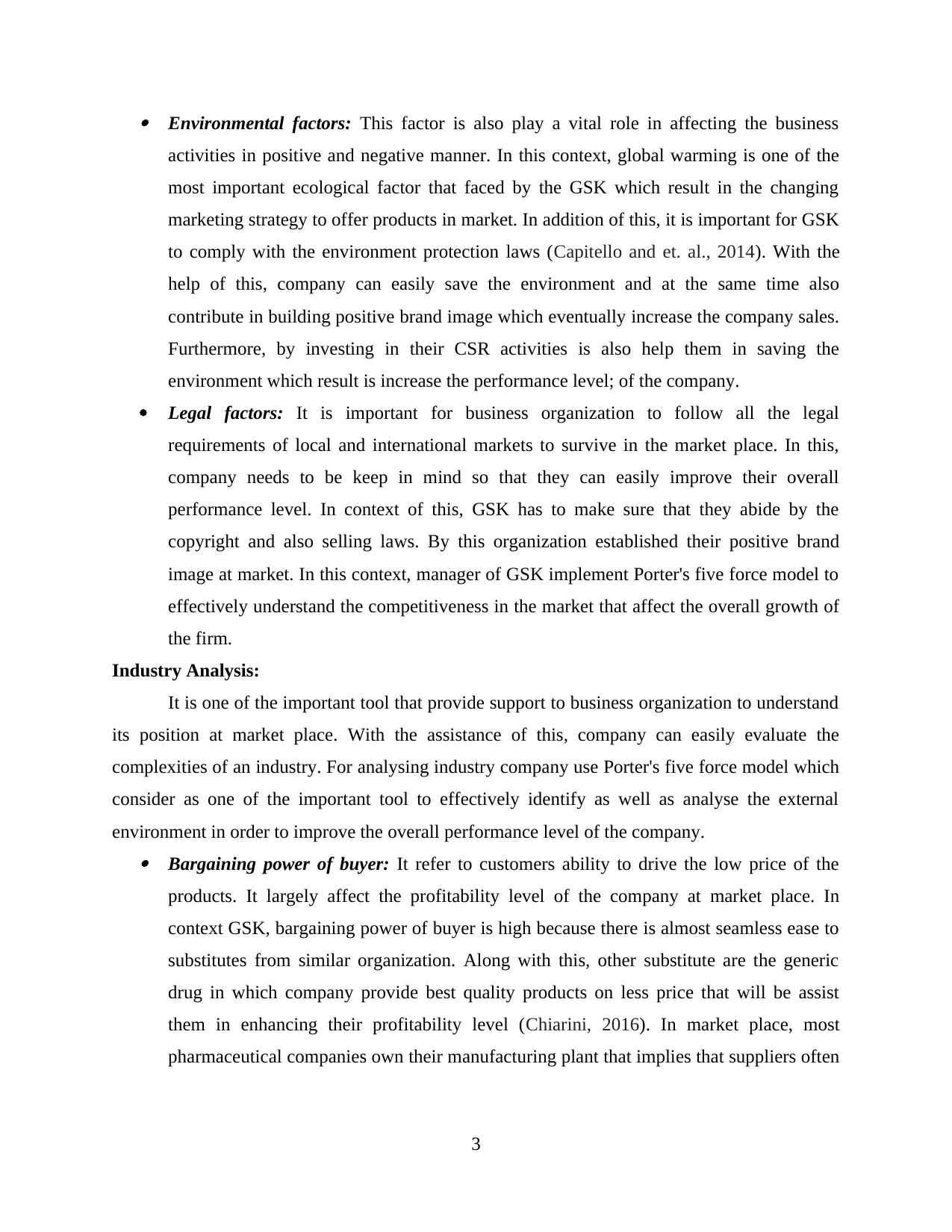
Environmental factors: This factor is also play a vital role in affecting the business
activities in positive and negative manner. In this context, global warming is one of the
most important ecological factor that faced by the GSK which result in the changing
marketing strategy to offer products in market. In addition of this, it is important for GSK
to comply with the environment protection laws (Capitello and et. al., 2014). With the
help of this, company can easily save the environment and at the same time also
contribute in building positive brand image which eventually increase the company sales.
Furthermore, by investing in their CSR activities is also help them in saving the
environment which result is increase the performance level; of the company.
Legal factors: It is important for business organization to follow all the legal
requirements of local and international markets to survive in the market place. In this,
company needs to be keep in mind so that they can easily improve their overall
performance level. In context of this, GSK has to make sure that they abide by the
copyright and also selling laws. By this organization established their positive brand
image at market. In this context, manager of GSK implement Porter's five force model to
effectively understand the competitiveness in the market that affect the overall growth of
the firm.
Industry Analysis:
It is one of the important tool that provide support to business organization to understand
its position at market place. With the assistance of this, company can easily evaluate the
complexities of an industry. For analysing industry company use Porter's five force model which
consider as one of the important tool to effectively identify as well as analyse the external
environment in order to improve the overall performance level of the company. Bargaining power of buyer: It refer to customers ability to drive the low price of the
products. It largely affect the profitability level of the company at market place. In
context GSK, bargaining power of buyer is high because there is almost seamless ease to
substitutes from similar organization. Along with this, other substitute are the generic
drug in which company provide best quality products on less price that will be assist
them in enhancing their profitability level (Chiarini, 2016). In market place, most
pharmaceutical companies own their manufacturing plant that implies that suppliers often
3
activities in positive and negative manner. In this context, global warming is one of the
most important ecological factor that faced by the GSK which result in the changing
marketing strategy to offer products in market. In addition of this, it is important for GSK
to comply with the environment protection laws (Capitello and et. al., 2014). With the
help of this, company can easily save the environment and at the same time also
contribute in building positive brand image which eventually increase the company sales.
Furthermore, by investing in their CSR activities is also help them in saving the
environment which result is increase the performance level; of the company.
Legal factors: It is important for business organization to follow all the legal
requirements of local and international markets to survive in the market place. In this,
company needs to be keep in mind so that they can easily improve their overall
performance level. In context of this, GSK has to make sure that they abide by the
copyright and also selling laws. By this organization established their positive brand
image at market. In this context, manager of GSK implement Porter's five force model to
effectively understand the competitiveness in the market that affect the overall growth of
the firm.
Industry Analysis:
It is one of the important tool that provide support to business organization to understand
its position at market place. With the assistance of this, company can easily evaluate the
complexities of an industry. For analysing industry company use Porter's five force model which
consider as one of the important tool to effectively identify as well as analyse the external
environment in order to improve the overall performance level of the company. Bargaining power of buyer: It refer to customers ability to drive the low price of the
products. It largely affect the profitability level of the company at market place. In
context GSK, bargaining power of buyer is high because there is almost seamless ease to
substitutes from similar organization. Along with this, other substitute are the generic
drug in which company provide best quality products on less price that will be assist
them in enhancing their profitability level (Chiarini, 2016). In market place, most
pharmaceutical companies own their manufacturing plant that implies that suppliers often
3
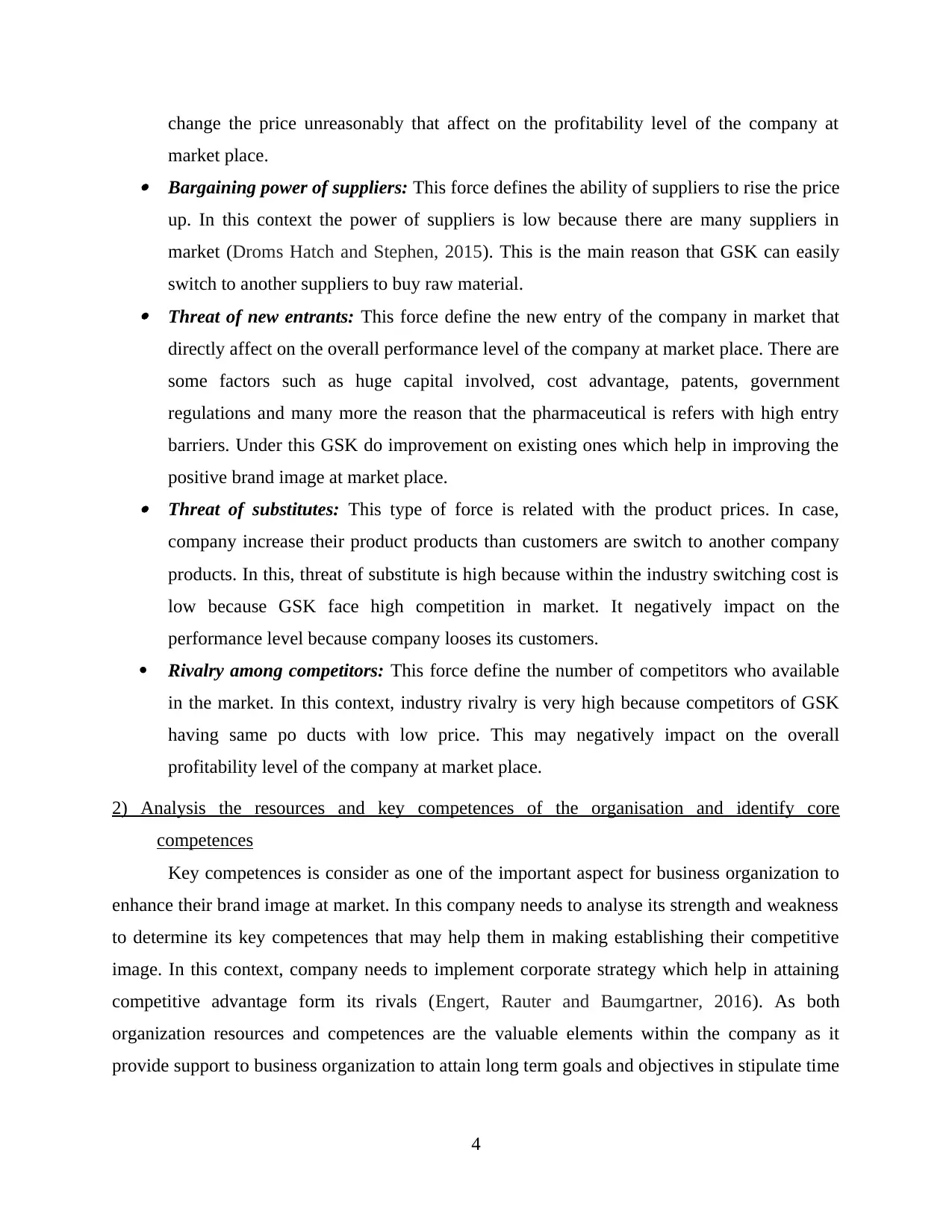
change the price unreasonably that affect on the profitability level of the company at
market place. Bargaining power of suppliers: This force defines the ability of suppliers to rise the price
up. In this context the power of suppliers is low because there are many suppliers in
market (Droms Hatch and Stephen, 2015). This is the main reason that GSK can easily
switch to another suppliers to buy raw material. Threat of new entrants: This force define the new entry of the company in market that
directly affect on the overall performance level of the company at market place. There are
some factors such as huge capital involved, cost advantage, patents, government
regulations and many more the reason that the pharmaceutical is refers with high entry
barriers. Under this GSK do improvement on existing ones which help in improving the
positive brand image at market place. Threat of substitutes: This type of force is related with the product prices. In case,
company increase their product products than customers are switch to another company
products. In this, threat of substitute is high because within the industry switching cost is
low because GSK face high competition in market. It negatively impact on the
performance level because company looses its customers.
Rivalry among competitors: This force define the number of competitors who available
in the market. In this context, industry rivalry is very high because competitors of GSK
having same po ducts with low price. This may negatively impact on the overall
profitability level of the company at market place.
2) Analysis the resources and key competences of the organisation and identify core
competences
Key competences is consider as one of the important aspect for business organization to
enhance their brand image at market. In this company needs to analyse its strength and weakness
to determine its key competences that may help them in making establishing their competitive
image. In this context, company needs to implement corporate strategy which help in attaining
competitive advantage form its rivals (Engert, Rauter and Baumgartner, 2016). As both
organization resources and competences are the valuable elements within the company as it
provide support to business organization to attain long term goals and objectives in stipulate time
4
market place. Bargaining power of suppliers: This force defines the ability of suppliers to rise the price
up. In this context the power of suppliers is low because there are many suppliers in
market (Droms Hatch and Stephen, 2015). This is the main reason that GSK can easily
switch to another suppliers to buy raw material. Threat of new entrants: This force define the new entry of the company in market that
directly affect on the overall performance level of the company at market place. There are
some factors such as huge capital involved, cost advantage, patents, government
regulations and many more the reason that the pharmaceutical is refers with high entry
barriers. Under this GSK do improvement on existing ones which help in improving the
positive brand image at market place. Threat of substitutes: This type of force is related with the product prices. In case,
company increase their product products than customers are switch to another company
products. In this, threat of substitute is high because within the industry switching cost is
low because GSK face high competition in market. It negatively impact on the
performance level because company looses its customers.
Rivalry among competitors: This force define the number of competitors who available
in the market. In this context, industry rivalry is very high because competitors of GSK
having same po ducts with low price. This may negatively impact on the overall
profitability level of the company at market place.
2) Analysis the resources and key competences of the organisation and identify core
competences
Key competences is consider as one of the important aspect for business organization to
enhance their brand image at market. In this company needs to analyse its strength and weakness
to determine its key competences that may help them in making establishing their competitive
image. In this context, company needs to implement corporate strategy which help in attaining
competitive advantage form its rivals (Engert, Rauter and Baumgartner, 2016). As both
organization resources and competences are the valuable elements within the company as it
provide support to business organization to attain long term goals and objectives in stipulate time
4
⊘ This is a preview!⊘
Do you want full access?
Subscribe today to unlock all pages.

Trusted by 1+ million students worldwide
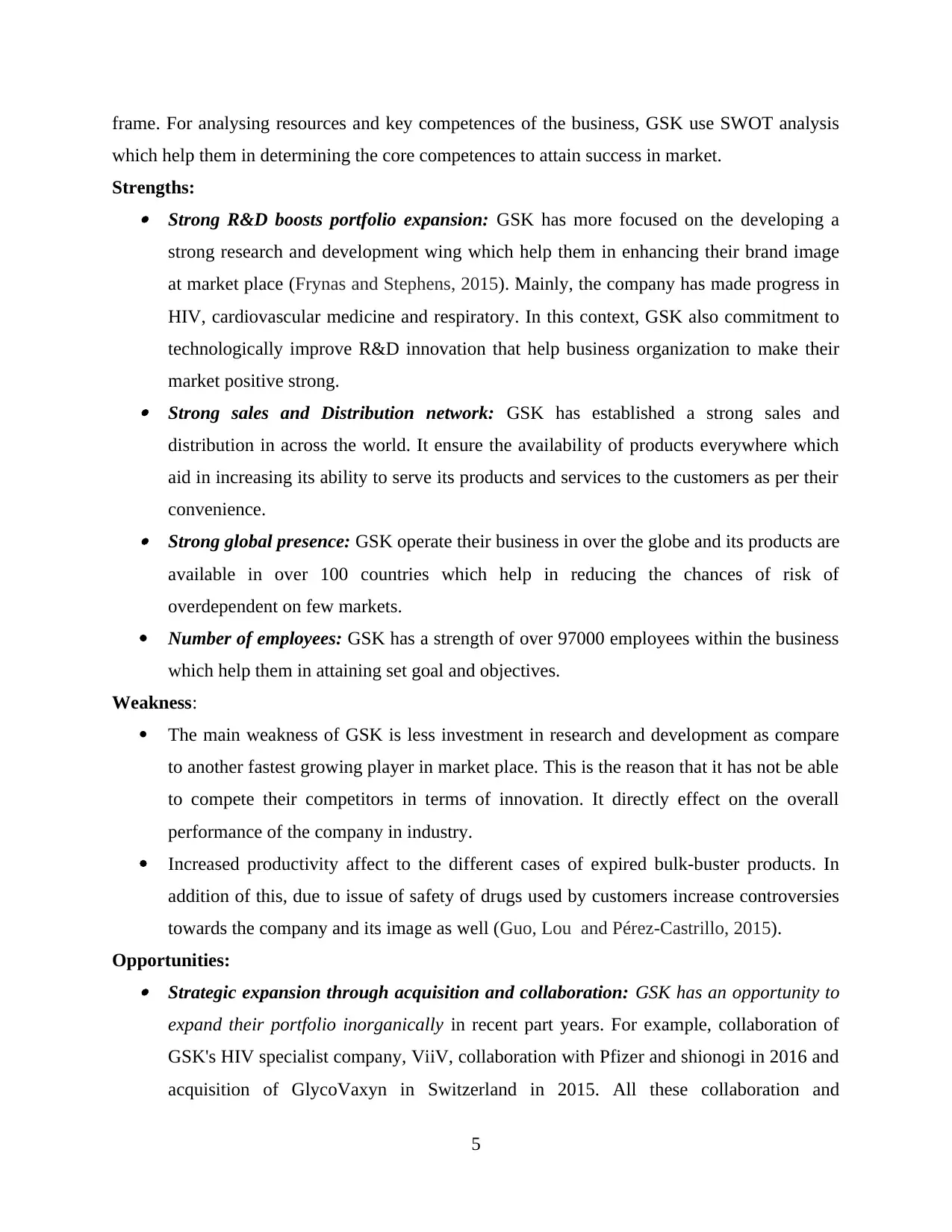
frame. For analysing resources and key competences of the business, GSK use SWOT analysis
which help them in determining the core competences to attain success in market.
Strengths: Strong R&D boosts portfolio expansion: GSK has more focused on the developing a
strong research and development wing which help them in enhancing their brand image
at market place (Frynas and Stephens, 2015). Mainly, the company has made progress in
HIV, cardiovascular medicine and respiratory. In this context, GSK also commitment to
technologically improve R&D innovation that help business organization to make their
market positive strong. Strong sales and Distribution network: GSK has established a strong sales and
distribution in across the world. It ensure the availability of products everywhere which
aid in increasing its ability to serve its products and services to the customers as per their
convenience. Strong global presence: GSK operate their business in over the globe and its products are
available in over 100 countries which help in reducing the chances of risk of
overdependent on few markets.
Number of employees: GSK has a strength of over 97000 employees within the business
which help them in attaining set goal and objectives.
Weakness:
The main weakness of GSK is less investment in research and development as compare
to another fastest growing player in market place. This is the reason that it has not be able
to compete their competitors in terms of innovation. It directly effect on the overall
performance of the company in industry.
Increased productivity affect to the different cases of expired bulk-buster products. In
addition of this, due to issue of safety of drugs used by customers increase controversies
towards the company and its image as well (Guo, Lou and Pérez‐Castrillo, 2015).
Opportunities: Strategic expansion through acquisition and collaboration: GSK has an opportunity to
expand their portfolio inorganically in recent part years. For example, collaboration of
GSK's HIV specialist company, ViiV, collaboration with Pfizer and shionogi in 2016 and
acquisition of GlycoVaxyn in Switzerland in 2015. All these collaboration and
5
which help them in determining the core competences to attain success in market.
Strengths: Strong R&D boosts portfolio expansion: GSK has more focused on the developing a
strong research and development wing which help them in enhancing their brand image
at market place (Frynas and Stephens, 2015). Mainly, the company has made progress in
HIV, cardiovascular medicine and respiratory. In this context, GSK also commitment to
technologically improve R&D innovation that help business organization to make their
market positive strong. Strong sales and Distribution network: GSK has established a strong sales and
distribution in across the world. It ensure the availability of products everywhere which
aid in increasing its ability to serve its products and services to the customers as per their
convenience. Strong global presence: GSK operate their business in over the globe and its products are
available in over 100 countries which help in reducing the chances of risk of
overdependent on few markets.
Number of employees: GSK has a strength of over 97000 employees within the business
which help them in attaining set goal and objectives.
Weakness:
The main weakness of GSK is less investment in research and development as compare
to another fastest growing player in market place. This is the reason that it has not be able
to compete their competitors in terms of innovation. It directly effect on the overall
performance of the company in industry.
Increased productivity affect to the different cases of expired bulk-buster products. In
addition of this, due to issue of safety of drugs used by customers increase controversies
towards the company and its image as well (Guo, Lou and Pérez‐Castrillo, 2015).
Opportunities: Strategic expansion through acquisition and collaboration: GSK has an opportunity to
expand their portfolio inorganically in recent part years. For example, collaboration of
GSK's HIV specialist company, ViiV, collaboration with Pfizer and shionogi in 2016 and
acquisition of GlycoVaxyn in Switzerland in 2015. All these collaboration and
5
Paraphrase This Document
Need a fresh take? Get an instant paraphrase of this document with our AI Paraphraser
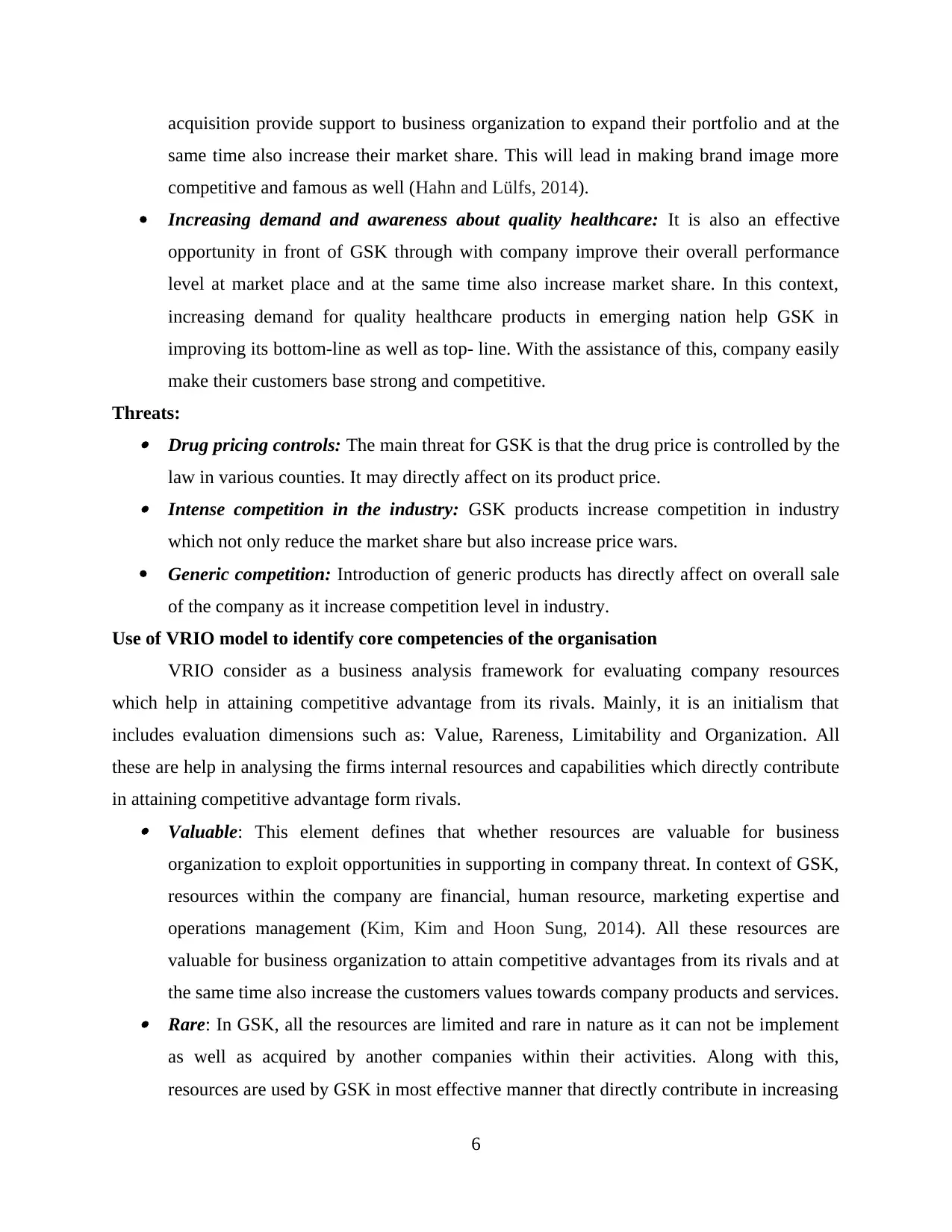
acquisition provide support to business organization to expand their portfolio and at the
same time also increase their market share. This will lead in making brand image more
competitive and famous as well (Hahn and Lülfs, 2014).
Increasing demand and awareness about quality healthcare: It is also an effective
opportunity in front of GSK through with company improve their overall performance
level at market place and at the same time also increase market share. In this context,
increasing demand for quality healthcare products in emerging nation help GSK in
improving its bottom-line as well as top- line. With the assistance of this, company easily
make their customers base strong and competitive.
Threats: Drug pricing controls: The main threat for GSK is that the drug price is controlled by the
law in various counties. It may directly affect on its product price. Intense competition in the industry: GSK products increase competition in industry
which not only reduce the market share but also increase price wars.
Generic competition: Introduction of generic products has directly affect on overall sale
of the company as it increase competition level in industry.
Use of VRIO model to identify core competencies of the organisation
VRIO consider as a business analysis framework for evaluating company resources
which help in attaining competitive advantage from its rivals. Mainly, it is an initialism that
includes evaluation dimensions such as: Value, Rareness, Limitability and Organization. All
these are help in analysing the firms internal resources and capabilities which directly contribute
in attaining competitive advantage form rivals. Valuable: This element defines that whether resources are valuable for business
organization to exploit opportunities in supporting in company threat. In context of GSK,
resources within the company are financial, human resource, marketing expertise and
operations management (Kim, Kim and Hoon Sung, 2014). All these resources are
valuable for business organization to attain competitive advantages from its rivals and at
the same time also increase the customers values towards company products and services. Rare: In GSK, all the resources are limited and rare in nature as it can not be implement
as well as acquired by another companies within their activities. Along with this,
resources are used by GSK in most effective manner that directly contribute in increasing
6
same time also increase their market share. This will lead in making brand image more
competitive and famous as well (Hahn and Lülfs, 2014).
Increasing demand and awareness about quality healthcare: It is also an effective
opportunity in front of GSK through with company improve their overall performance
level at market place and at the same time also increase market share. In this context,
increasing demand for quality healthcare products in emerging nation help GSK in
improving its bottom-line as well as top- line. With the assistance of this, company easily
make their customers base strong and competitive.
Threats: Drug pricing controls: The main threat for GSK is that the drug price is controlled by the
law in various counties. It may directly affect on its product price. Intense competition in the industry: GSK products increase competition in industry
which not only reduce the market share but also increase price wars.
Generic competition: Introduction of generic products has directly affect on overall sale
of the company as it increase competition level in industry.
Use of VRIO model to identify core competencies of the organisation
VRIO consider as a business analysis framework for evaluating company resources
which help in attaining competitive advantage from its rivals. Mainly, it is an initialism that
includes evaluation dimensions such as: Value, Rareness, Limitability and Organization. All
these are help in analysing the firms internal resources and capabilities which directly contribute
in attaining competitive advantage form rivals. Valuable: This element defines that whether resources are valuable for business
organization to exploit opportunities in supporting in company threat. In context of GSK,
resources within the company are financial, human resource, marketing expertise and
operations management (Kim, Kim and Hoon Sung, 2014). All these resources are
valuable for business organization to attain competitive advantages from its rivals and at
the same time also increase the customers values towards company products and services. Rare: In GSK, all the resources are limited and rare in nature as it can not be implement
as well as acquired by another companies within their activities. Along with this,
resources are used by GSK in most effective manner that directly contribute in increasing
6
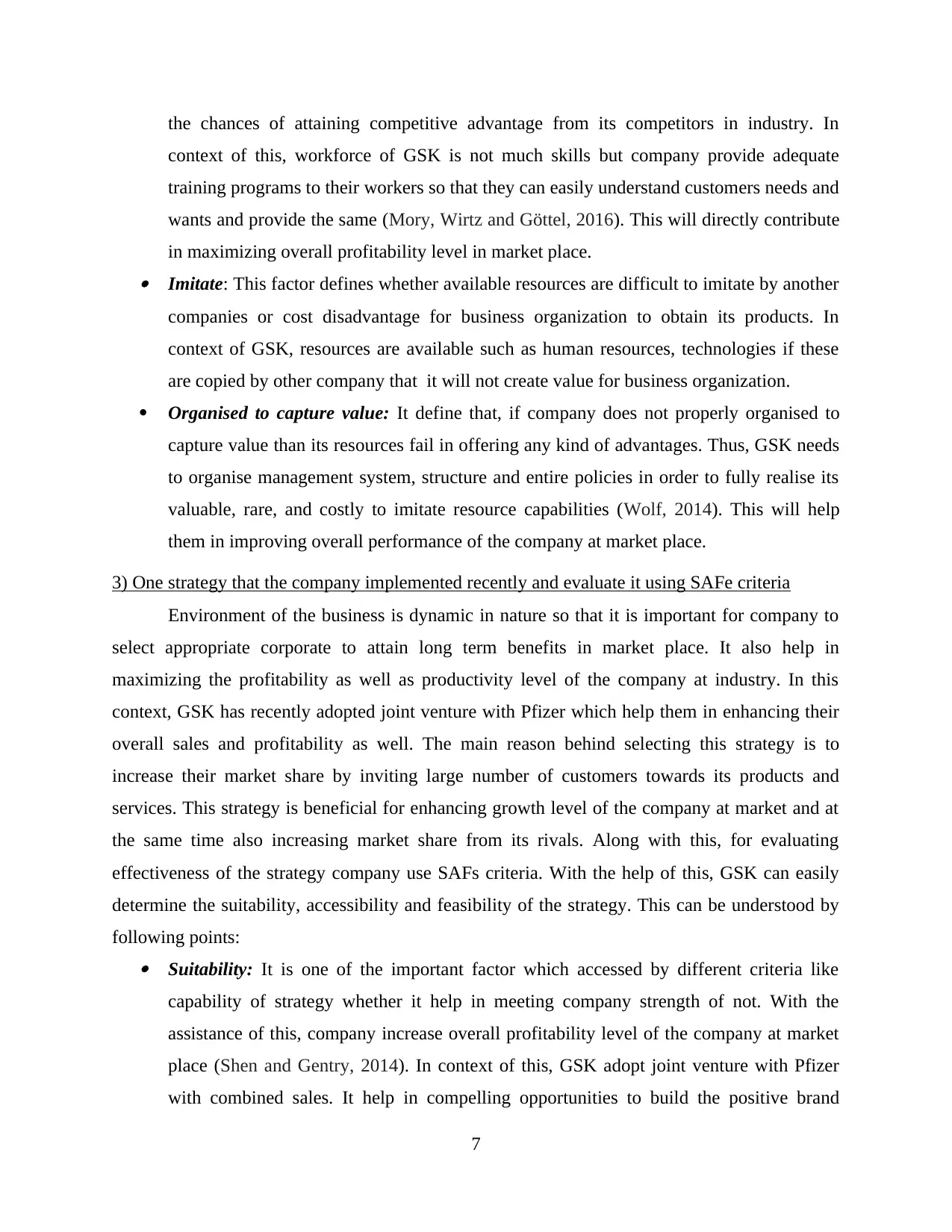
the chances of attaining competitive advantage from its competitors in industry. In
context of this, workforce of GSK is not much skills but company provide adequate
training programs to their workers so that they can easily understand customers needs and
wants and provide the same (Mory, Wirtz and Göttel, 2016). This will directly contribute
in maximizing overall profitability level in market place. Imitate: This factor defines whether available resources are difficult to imitate by another
companies or cost disadvantage for business organization to obtain its products. In
context of GSK, resources are available such as human resources, technologies if these
are copied by other company that it will not create value for business organization.
Organised to capture value: It define that, if company does not properly organised to
capture value than its resources fail in offering any kind of advantages. Thus, GSK needs
to organise management system, structure and entire policies in order to fully realise its
valuable, rare, and costly to imitate resource capabilities (Wolf, 2014). This will help
them in improving overall performance of the company at market place.
3) One strategy that the company implemented recently and evaluate it using SAFe criteria
Environment of the business is dynamic in nature so that it is important for company to
select appropriate corporate to attain long term benefits in market place. It also help in
maximizing the profitability as well as productivity level of the company at industry. In this
context, GSK has recently adopted joint venture with Pfizer which help them in enhancing their
overall sales and profitability as well. The main reason behind selecting this strategy is to
increase their market share by inviting large number of customers towards its products and
services. This strategy is beneficial for enhancing growth level of the company at market and at
the same time also increasing market share from its rivals. Along with this, for evaluating
effectiveness of the strategy company use SAFs criteria. With the help of this, GSK can easily
determine the suitability, accessibility and feasibility of the strategy. This can be understood by
following points: Suitability: It is one of the important factor which accessed by different criteria like
capability of strategy whether it help in meeting company strength of not. With the
assistance of this, company increase overall profitability level of the company at market
place (Shen and Gentry, 2014). In context of this, GSK adopt joint venture with Pfizer
with combined sales. It help in compelling opportunities to build the positive brand
7
context of this, workforce of GSK is not much skills but company provide adequate
training programs to their workers so that they can easily understand customers needs and
wants and provide the same (Mory, Wirtz and Göttel, 2016). This will directly contribute
in maximizing overall profitability level in market place. Imitate: This factor defines whether available resources are difficult to imitate by another
companies or cost disadvantage for business organization to obtain its products. In
context of GSK, resources are available such as human resources, technologies if these
are copied by other company that it will not create value for business organization.
Organised to capture value: It define that, if company does not properly organised to
capture value than its resources fail in offering any kind of advantages. Thus, GSK needs
to organise management system, structure and entire policies in order to fully realise its
valuable, rare, and costly to imitate resource capabilities (Wolf, 2014). This will help
them in improving overall performance of the company at market place.
3) One strategy that the company implemented recently and evaluate it using SAFe criteria
Environment of the business is dynamic in nature so that it is important for company to
select appropriate corporate to attain long term benefits in market place. It also help in
maximizing the profitability as well as productivity level of the company at industry. In this
context, GSK has recently adopted joint venture with Pfizer which help them in enhancing their
overall sales and profitability as well. The main reason behind selecting this strategy is to
increase their market share by inviting large number of customers towards its products and
services. This strategy is beneficial for enhancing growth level of the company at market and at
the same time also increasing market share from its rivals. Along with this, for evaluating
effectiveness of the strategy company use SAFs criteria. With the help of this, GSK can easily
determine the suitability, accessibility and feasibility of the strategy. This can be understood by
following points: Suitability: It is one of the important factor which accessed by different criteria like
capability of strategy whether it help in meeting company strength of not. With the
assistance of this, company increase overall profitability level of the company at market
place (Shen and Gentry, 2014). In context of this, GSK adopt joint venture with Pfizer
with combined sales. It help in compelling opportunities to build the positive brand
7
⊘ This is a preview!⊘
Do you want full access?
Subscribe today to unlock all pages.

Trusted by 1+ million students worldwide
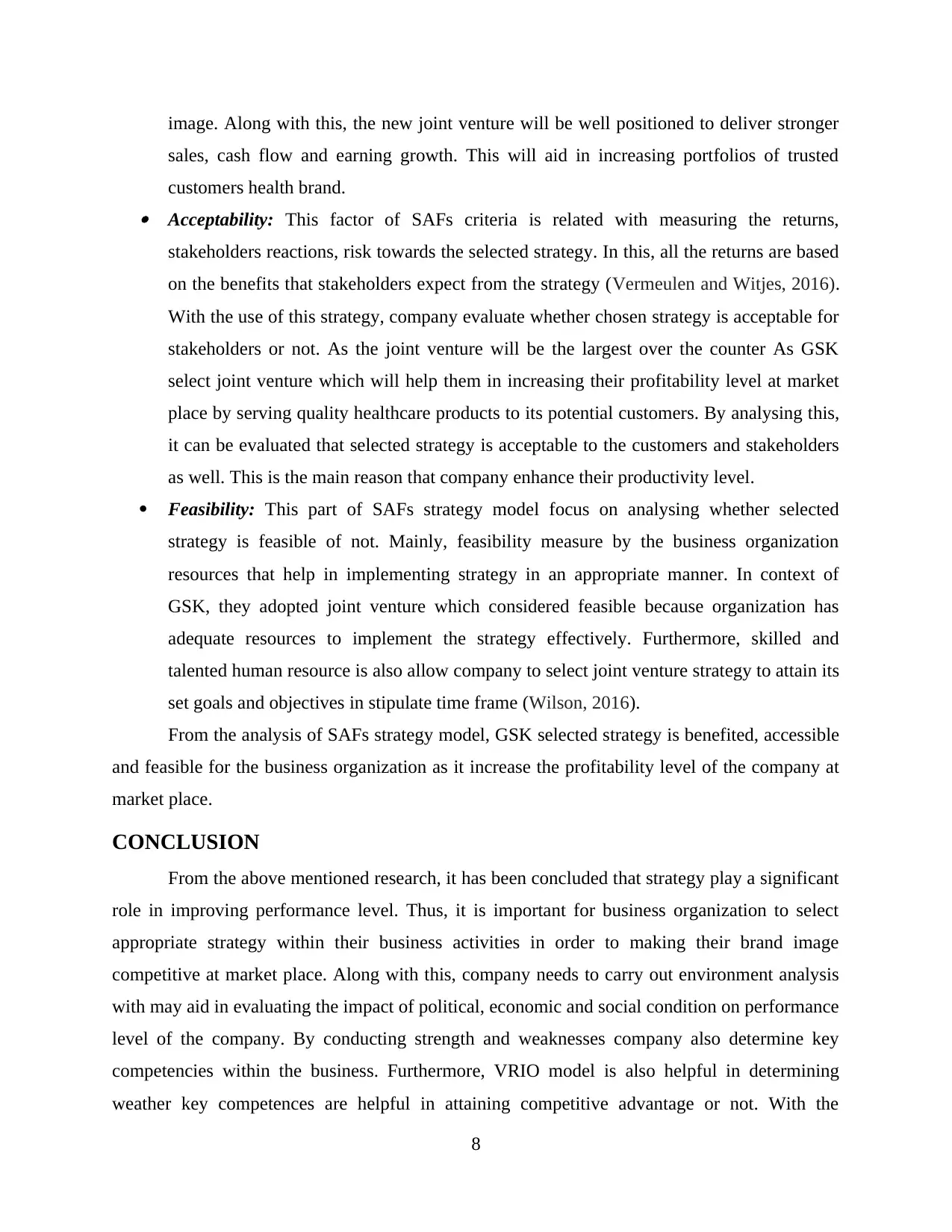
image. Along with this, the new joint venture will be well positioned to deliver stronger
sales, cash flow and earning growth. This will aid in increasing portfolios of trusted
customers health brand. Acceptability: This factor of SAFs criteria is related with measuring the returns,
stakeholders reactions, risk towards the selected strategy. In this, all the returns are based
on the benefits that stakeholders expect from the strategy (Vermeulen and Witjes, 2016).
With the use of this strategy, company evaluate whether chosen strategy is acceptable for
stakeholders or not. As the joint venture will be the largest over the counter As GSK
select joint venture which will help them in increasing their profitability level at market
place by serving quality healthcare products to its potential customers. By analysing this,
it can be evaluated that selected strategy is acceptable to the customers and stakeholders
as well. This is the main reason that company enhance their productivity level.
Feasibility: This part of SAFs strategy model focus on analysing whether selected
strategy is feasible of not. Mainly, feasibility measure by the business organization
resources that help in implementing strategy in an appropriate manner. In context of
GSK, they adopted joint venture which considered feasible because organization has
adequate resources to implement the strategy effectively. Furthermore, skilled and
talented human resource is also allow company to select joint venture strategy to attain its
set goals and objectives in stipulate time frame (Wilson, 2016).
From the analysis of SAFs strategy model, GSK selected strategy is benefited, accessible
and feasible for the business organization as it increase the profitability level of the company at
market place.
CONCLUSION
From the above mentioned research, it has been concluded that strategy play a significant
role in improving performance level. Thus, it is important for business organization to select
appropriate strategy within their business activities in order to making their brand image
competitive at market place. Along with this, company needs to carry out environment analysis
with may aid in evaluating the impact of political, economic and social condition on performance
level of the company. By conducting strength and weaknesses company also determine key
competencies within the business. Furthermore, VRIO model is also helpful in determining
weather key competences are helpful in attaining competitive advantage or not. With the
8
sales, cash flow and earning growth. This will aid in increasing portfolios of trusted
customers health brand. Acceptability: This factor of SAFs criteria is related with measuring the returns,
stakeholders reactions, risk towards the selected strategy. In this, all the returns are based
on the benefits that stakeholders expect from the strategy (Vermeulen and Witjes, 2016).
With the use of this strategy, company evaluate whether chosen strategy is acceptable for
stakeholders or not. As the joint venture will be the largest over the counter As GSK
select joint venture which will help them in increasing their profitability level at market
place by serving quality healthcare products to its potential customers. By analysing this,
it can be evaluated that selected strategy is acceptable to the customers and stakeholders
as well. This is the main reason that company enhance their productivity level.
Feasibility: This part of SAFs strategy model focus on analysing whether selected
strategy is feasible of not. Mainly, feasibility measure by the business organization
resources that help in implementing strategy in an appropriate manner. In context of
GSK, they adopted joint venture which considered feasible because organization has
adequate resources to implement the strategy effectively. Furthermore, skilled and
talented human resource is also allow company to select joint venture strategy to attain its
set goals and objectives in stipulate time frame (Wilson, 2016).
From the analysis of SAFs strategy model, GSK selected strategy is benefited, accessible
and feasible for the business organization as it increase the profitability level of the company at
market place.
CONCLUSION
From the above mentioned research, it has been concluded that strategy play a significant
role in improving performance level. Thus, it is important for business organization to select
appropriate strategy within their business activities in order to making their brand image
competitive at market place. Along with this, company needs to carry out environment analysis
with may aid in evaluating the impact of political, economic and social condition on performance
level of the company. By conducting strength and weaknesses company also determine key
competencies within the business. Furthermore, VRIO model is also helpful in determining
weather key competences are helpful in attaining competitive advantage or not. With the
8
Paraphrase This Document
Need a fresh take? Get an instant paraphrase of this document with our AI Paraphraser
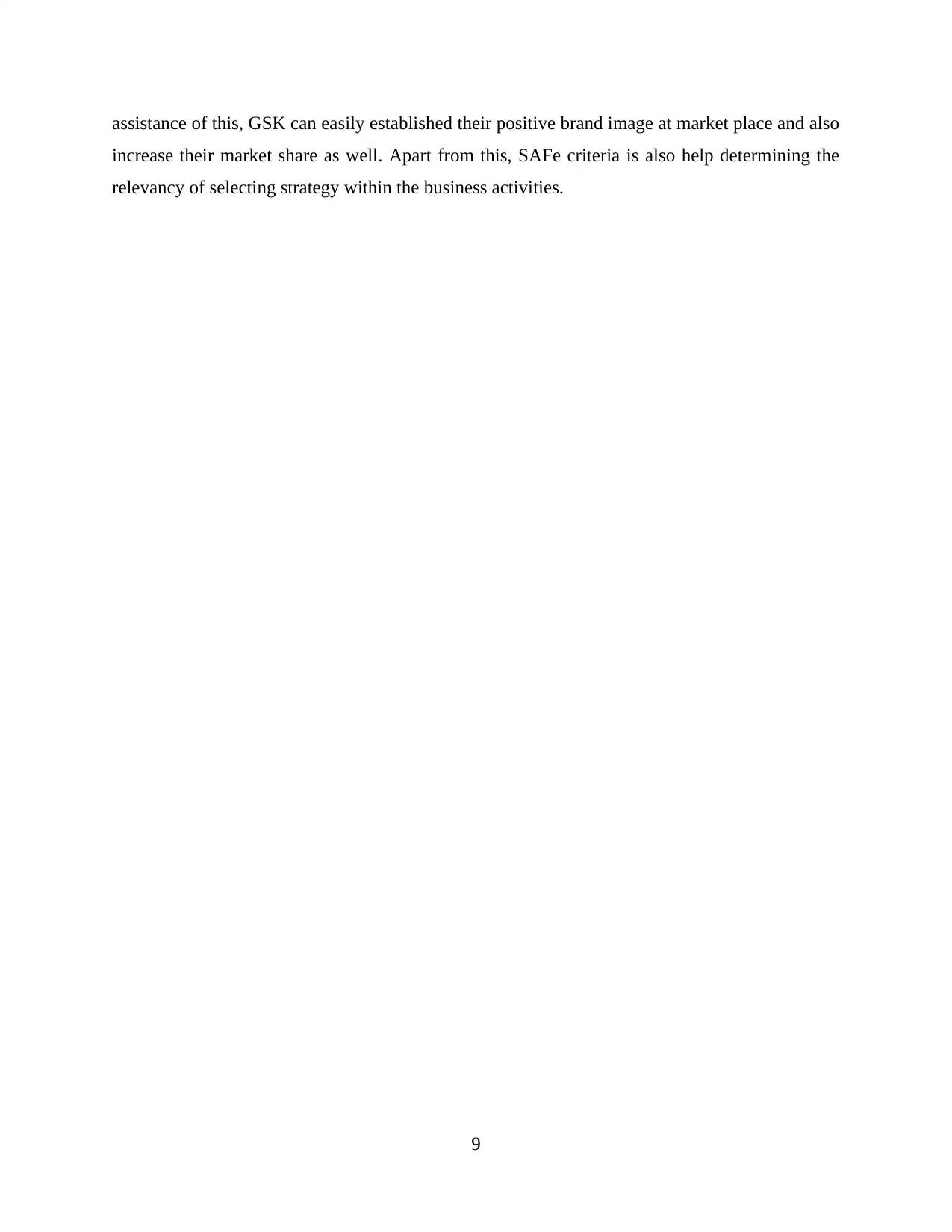
assistance of this, GSK can easily established their positive brand image at market place and also
increase their market share as well. Apart from this, SAFe criteria is also help determining the
relevancy of selecting strategy within the business activities.
9
increase their market share as well. Apart from this, SAFe criteria is also help determining the
relevancy of selecting strategy within the business activities.
9
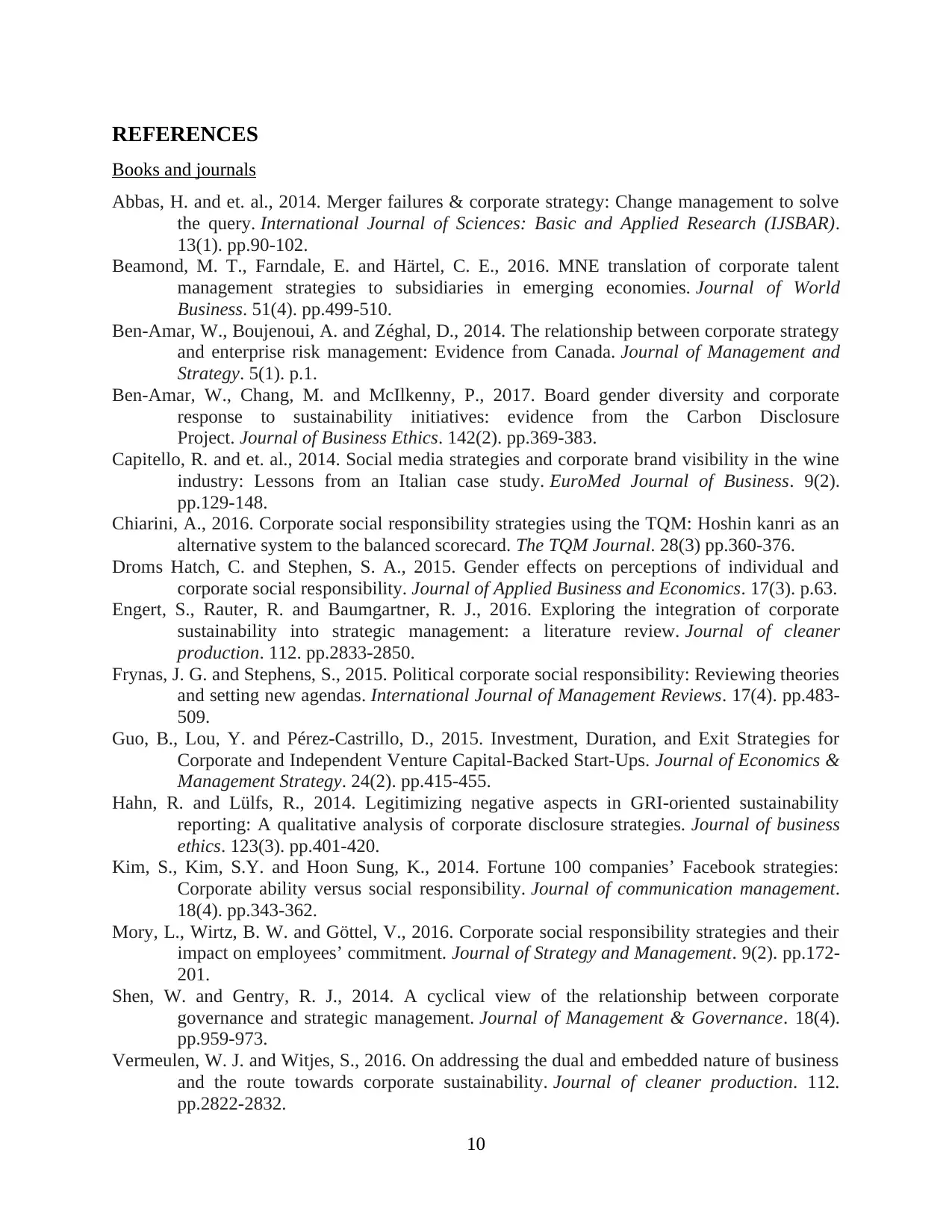
REFERENCES
Books and journals
Abbas, H. and et. al., 2014. Merger failures & corporate strategy: Change management to solve
the query. International Journal of Sciences: Basic and Applied Research (IJSBAR).
13(1). pp.90-102.
Beamond, M. T., Farndale, E. and Härtel, C. E., 2016. MNE translation of corporate talent
management strategies to subsidiaries in emerging economies. Journal of World
Business. 51(4). pp.499-510.
Ben-Amar, W., Boujenoui, A. and Zéghal, D., 2014. The relationship between corporate strategy
and enterprise risk management: Evidence from Canada. Journal of Management and
Strategy. 5(1). p.1.
Ben-Amar, W., Chang, M. and McIlkenny, P., 2017. Board gender diversity and corporate
response to sustainability initiatives: evidence from the Carbon Disclosure
Project. Journal of Business Ethics. 142(2). pp.369-383.
Capitello, R. and et. al., 2014. Social media strategies and corporate brand visibility in the wine
industry: Lessons from an Italian case study. EuroMed Journal of Business. 9(2).
pp.129-148.
Chiarini, A., 2016. Corporate social responsibility strategies using the TQM: Hoshin kanri as an
alternative system to the balanced scorecard. The TQM Journal. 28(3) pp.360-376.
Droms Hatch, C. and Stephen, S. A., 2015. Gender effects on perceptions of individual and
corporate social responsibility. Journal of Applied Business and Economics. 17(3). p.63.
Engert, S., Rauter, R. and Baumgartner, R. J., 2016. Exploring the integration of corporate
sustainability into strategic management: a literature review. Journal of cleaner
production. 112. pp.2833-2850.
Frynas, J. G. and Stephens, S., 2015. Political corporate social responsibility: Reviewing theories
and setting new agendas. International Journal of Management Reviews. 17(4). pp.483-
509.
Guo, B., Lou, Y. and Pérez‐Castrillo, D., 2015. Investment, Duration, and Exit Strategies for
Corporate and Independent Venture Capital‐Backed Start‐Ups. Journal of Economics &
Management Strategy. 24(2). pp.415-455.
Hahn, R. and Lülfs, R., 2014. Legitimizing negative aspects in GRI-oriented sustainability
reporting: A qualitative analysis of corporate disclosure strategies. Journal of business
ethics. 123(3). pp.401-420.
Kim, S., Kim, S.Y. and Hoon Sung, K., 2014. Fortune 100 companies’ Facebook strategies:
Corporate ability versus social responsibility. Journal of communication management.
18(4). pp.343-362.
Mory, L., Wirtz, B. W. and Göttel, V., 2016. Corporate social responsibility strategies and their
impact on employees’ commitment. Journal of Strategy and Management. 9(2). pp.172-
201.
Shen, W. and Gentry, R. J., 2014. A cyclical view of the relationship between corporate
governance and strategic management. Journal of Management & Governance. 18(4).
pp.959-973.
Vermeulen, W. J. and Witjes, S., 2016. On addressing the dual and embedded nature of business
and the route towards corporate sustainability. Journal of cleaner production. 112.
pp.2822-2832.
10
Books and journals
Abbas, H. and et. al., 2014. Merger failures & corporate strategy: Change management to solve
the query. International Journal of Sciences: Basic and Applied Research (IJSBAR).
13(1). pp.90-102.
Beamond, M. T., Farndale, E. and Härtel, C. E., 2016. MNE translation of corporate talent
management strategies to subsidiaries in emerging economies. Journal of World
Business. 51(4). pp.499-510.
Ben-Amar, W., Boujenoui, A. and Zéghal, D., 2014. The relationship between corporate strategy
and enterprise risk management: Evidence from Canada. Journal of Management and
Strategy. 5(1). p.1.
Ben-Amar, W., Chang, M. and McIlkenny, P., 2017. Board gender diversity and corporate
response to sustainability initiatives: evidence from the Carbon Disclosure
Project. Journal of Business Ethics. 142(2). pp.369-383.
Capitello, R. and et. al., 2014. Social media strategies and corporate brand visibility in the wine
industry: Lessons from an Italian case study. EuroMed Journal of Business. 9(2).
pp.129-148.
Chiarini, A., 2016. Corporate social responsibility strategies using the TQM: Hoshin kanri as an
alternative system to the balanced scorecard. The TQM Journal. 28(3) pp.360-376.
Droms Hatch, C. and Stephen, S. A., 2015. Gender effects on perceptions of individual and
corporate social responsibility. Journal of Applied Business and Economics. 17(3). p.63.
Engert, S., Rauter, R. and Baumgartner, R. J., 2016. Exploring the integration of corporate
sustainability into strategic management: a literature review. Journal of cleaner
production. 112. pp.2833-2850.
Frynas, J. G. and Stephens, S., 2015. Political corporate social responsibility: Reviewing theories
and setting new agendas. International Journal of Management Reviews. 17(4). pp.483-
509.
Guo, B., Lou, Y. and Pérez‐Castrillo, D., 2015. Investment, Duration, and Exit Strategies for
Corporate and Independent Venture Capital‐Backed Start‐Ups. Journal of Economics &
Management Strategy. 24(2). pp.415-455.
Hahn, R. and Lülfs, R., 2014. Legitimizing negative aspects in GRI-oriented sustainability
reporting: A qualitative analysis of corporate disclosure strategies. Journal of business
ethics. 123(3). pp.401-420.
Kim, S., Kim, S.Y. and Hoon Sung, K., 2014. Fortune 100 companies’ Facebook strategies:
Corporate ability versus social responsibility. Journal of communication management.
18(4). pp.343-362.
Mory, L., Wirtz, B. W. and Göttel, V., 2016. Corporate social responsibility strategies and their
impact on employees’ commitment. Journal of Strategy and Management. 9(2). pp.172-
201.
Shen, W. and Gentry, R. J., 2014. A cyclical view of the relationship between corporate
governance and strategic management. Journal of Management & Governance. 18(4).
pp.959-973.
Vermeulen, W. J. and Witjes, S., 2016. On addressing the dual and embedded nature of business
and the route towards corporate sustainability. Journal of cleaner production. 112.
pp.2822-2832.
10
⊘ This is a preview!⊘
Do you want full access?
Subscribe today to unlock all pages.

Trusted by 1+ million students worldwide
1 out of 13
Related Documents
Your All-in-One AI-Powered Toolkit for Academic Success.
+13062052269
info@desklib.com
Available 24*7 on WhatsApp / Email
![[object Object]](/_next/static/media/star-bottom.7253800d.svg)
Unlock your academic potential
Copyright © 2020–2025 A2Z Services. All Rights Reserved. Developed and managed by ZUCOL.





